Shocking Ways Airlines Are Mistreating the Disabled
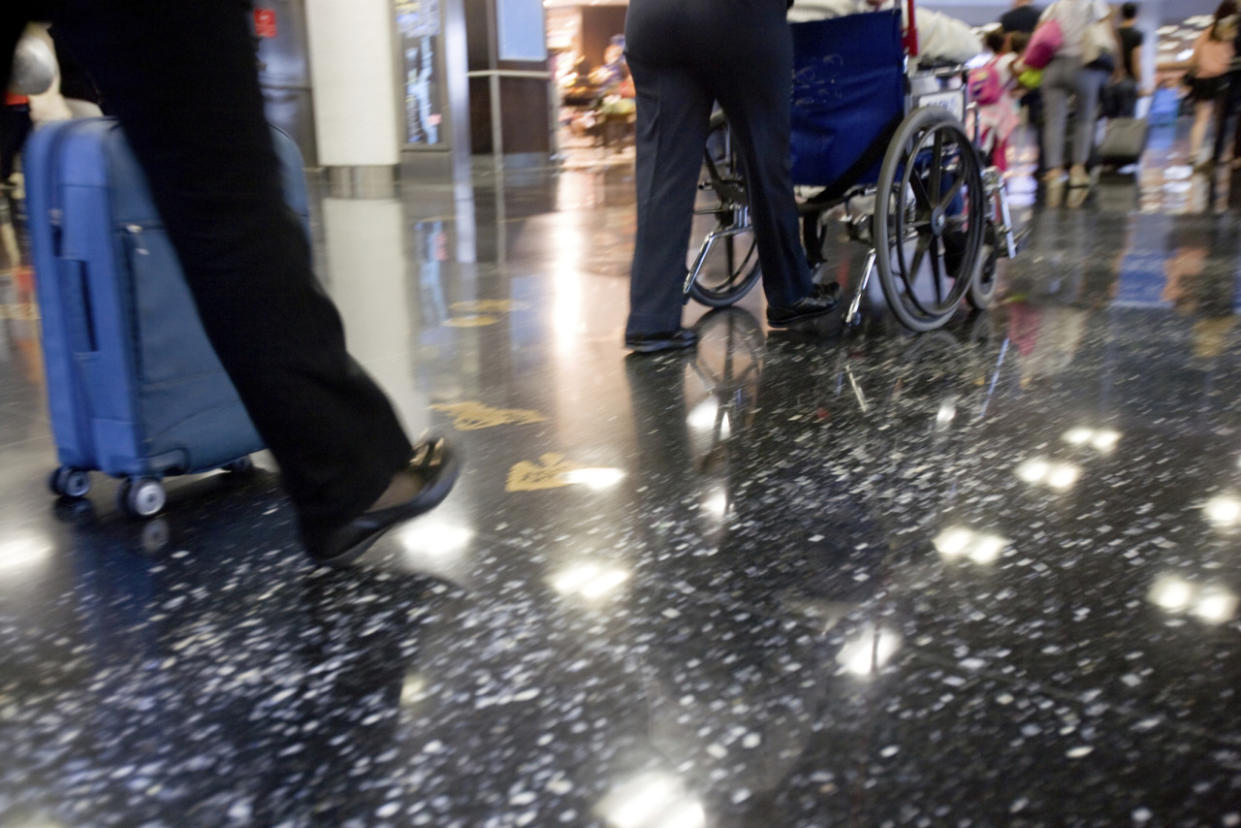
Photo: Thinkstock
It should have been just a routine business trip for Emily Ladau from New York City to Minnesota, where she was scheduled to speak at a disability rights conference. But the return flight home on Delta turned into a nightmare.
Ladau, who has Larsen Syndrome — a genetic joint and muscle disorder that has left her unable to walk — requires a wheelchair for transportation. The crew checked her wheelchair, like they always do, and escorted her to her seat on the plane via one of airline’s aisle wheelchairs. But she was in for a shock when they landed.
“When I arrived at the gate I discovered the staff had no idea where my wheelchair was,” she recalls. Even more disconcerting, none of the airline personnel seemed concerned. “They told me to walk over to baggage claim and file a missing luggage report,” she says. “By then, I was in tears, trying to explain to them, ‘How do you expect me to walk? My wheelchair is my legs!’ They were treating a $15,000 piece of equipment like a missing Samsonite suitcase.”
Related: No Limits: First Quadriplegic Woman Summits Kilimanjaro

Emily Ladau (Photo: Emily Ladau)
Ladau’s friend pushed her through the airport in the airline’s flimsy aisle chair, a process that was uncomfortable, jarring and took about 45 minutes. They found the wheelchair, sitting untagged in front of an office near baggage claim.
Passenger D’Arcee Neal made headlines recently when he crawled off of his flight after United Airlines failed to bring him his wheelchair. But while his story inspired outrage — and an apology from United — disability rights activists say his story is more the norm than the exception when it comes to air travel for people with physical disabilities.
Under the Air Carrier Access Act of 1986, airlines have a slew of regulations they need to comply with to meet the needs of people with disabilities, including movable aisle armrests, accessible bathrooms, and providing assistance when it comes to boarding, deplaning, and making connections. Yet the Department of Transportation (DOT) still receives 600 to 700 formal disability-related complaints per year, or about 5 percent of total airline passenger complaints annually. And the airlines themselves receive far more: over 27,500 in 2014 for both national and international travel, according to the DOT.
“For every claim filed, we believe there are at least 100 other individuals who experienced the same treatment who don’t bother filing complaints,” says Dara Baldwin, a public policy analyst at the National Disability Rights Network in Washington, D.C. Here, Yahoo uncovers some of the most common issues.
Wheelchair woes

Attorney Powell (Photo: Robyn Powell)
Disability rights attorney Robyn Powell has flown nine times over the past year— and seven of those times, her motorized wheelchair has been broken. “The airline always pays for it, but sometimes it takes up to a week to fix, and you have to make do with a loaner wheelchair, which is virtually useless,” she says.
She thinks most of the problem is due to staff not knowing how to load chairs properly. “One time I knew they were having trouble with the wheelchair because the pilot announced that it was the reason the [JetBlue] flight couldn’t take off on time,” she recalls. Powell’s friend offered to show the staff how to do it, but was told he couldn’t get off the plane for security purposes. In the meantime, the rest of the passengers — including Powell — had to sit on the runway for another half hour, silently fuming.
Nearly half of the complaints reported to airlines is failure to provide adequate assistance to people using wheelchairs. One reason is that passengers in wheelchairs have to be wheeled onto the plane via an aisle wheelchair, then physically lifted out and into their seat. If it’s not done properly, there’s risk of serious injury. It happened to spina bifida survivor Mary Dordiesk in 2014 — she reportedly suffered a broken leg after airline crew forced her leg to bend in order to get her into her seat.
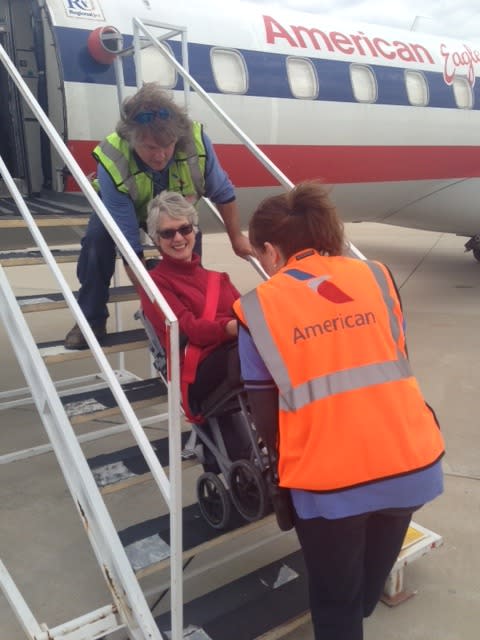
Allen in transit. (Photo: Jeanne Allen)
“I’ve found huge inconsistencies in how people buckle me into the aisle chair,” says Arizona wheelchair user Jeanne Allen, Founder of incredibleaccessible.com. “There have been times attendants haven’t figured out how to buckle me and I’ve had to hold the safety clip together with my fingers while they bump me down the aisle towards my seat.”
Bathroom barriers
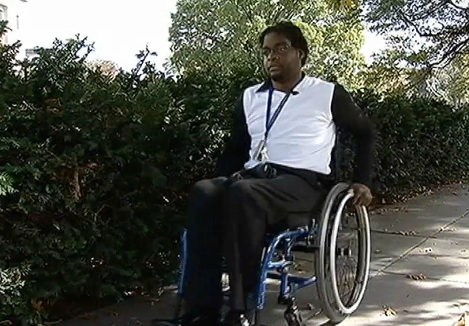
After United Airlines failed to bring him a wheelchair, D’Arcce Neal had no choice but to crawl off of the plane. (Photo: NBC News 4)
The reason Neal had to crawl off the United plane was because he urgently needed to use a bathroom and didn’t feel that he could wait around for someone to bring him an aisle chair. This is, unfortunately, a huge issue for many people who are wheelchair bound. Only new wide-body (twin-aisle) aircraft are required to provide accessible bathrooms, according to the ACAA. (Most domestic flights are single-aisle.) As a result, the disabled often have no choice but to hold it in on a domestic flight, points out Baldwin, since there’s simply no room for someone else to assist them in the tiny room.
Related: Man in Wheelchair Forced to Crawl Off Plane
Even when there are accessible lavatories, a seemingly simple procedure can still remain daunting, if not impossible: “there’s still not enough space to take equipment like a wheelchair in there,” says Allen. “I rely on my husband and attendant to pick me up and I just grab onto the bars. But it’s so humiliating that usually I just hold it.” Ladau agrees, noting she held it on for 14 hours on a recent trip to Israel on El Al. “I worried about getting dehydrated, but that seemed better than the alternative,” she says. “I just didn’t see how it was even possible.”
Clueless crew

Kuusisto and Nira (Photo: Stephen Kuusisto)
Stephen Kuusisto, a professor of disability studies at Syracuse University who is legally blind, travels frequently for work, always in the company of his faithful guide dog, Nira. But last year, when he tried to board a United Airlines plane, he was stopped by a flight attendant who informed him the canine — who had all her proper documentation — couldn’t board since she wasn’t sporting a blue blanket.
“I’m seldom speechless, but standing in the airplane doorway I was momentarily flummoxed,” he says. Kuusisto tried explaining to her that the dog didn’t need a blue blanket to come onto the plane, but she refused to listen. Exasperated, he sat down in his seat and tucked his dog under his feet, informing her she needed to check with her supervisor. She stormed off the plane — creating a traffic jam of passengers trying to board — and returned a few minutes later, totally silent.
“I’m guessing she was told it was OK,” he says wryly. “It would have been a lot less of a hassle for everybody if the airline had trained its flight attendants properly.”
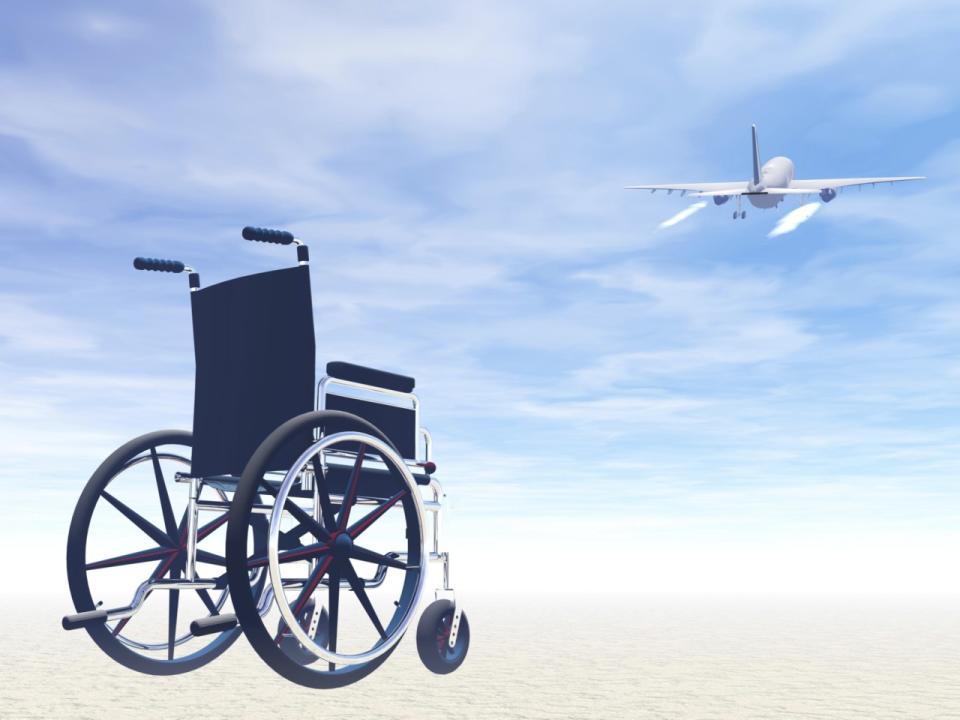
Photo: Thinkstock
Sometimes it’s not just downright ignorance about passengers’ legal rights, it’s downright ignorance, period. When Ladau needs to be lifted into her airplane seat, she needs to be held a certain way to help keep her body stable and reduce risk of injury. But when she tries to explain that to crew, they often look at her perplexed.
“They assume because I’m physically disabled, I can’t talk and can’t advocate for myself,” she explains. “Oftentimes, a crew member will ask the person I’m traveling with, ‘can she walk?’ And I have to pipe up for myself, ‘No, she can’t walk, but she can transfer.’ A few times I’ve been referred to — to my face — as ‘the wheelchair person.’ Is it illegal that they are doing that? No, but it’s dehumanizing and discouraging.”
Related: Special Needs Travelers Can Do Anything
Kuusisto believes much of the problem could be solved with more and better training of airline crew members, ranging from ground crew to flight attendants to pilots themselves.
“Even if a large airline such as United or American offers training to its staff, it’s not enough, because the companies are subcontracting to regional airlines who may not train staff effectively when it comes to disability,” he explains. “There’s still a deep belief in our society that it’s someone else’s job to handle the disabled, so if there isn’t sufficient training to help counter that, you are going to get employees who don’t really understand that everyone needs to be treated equally.”
What you can do
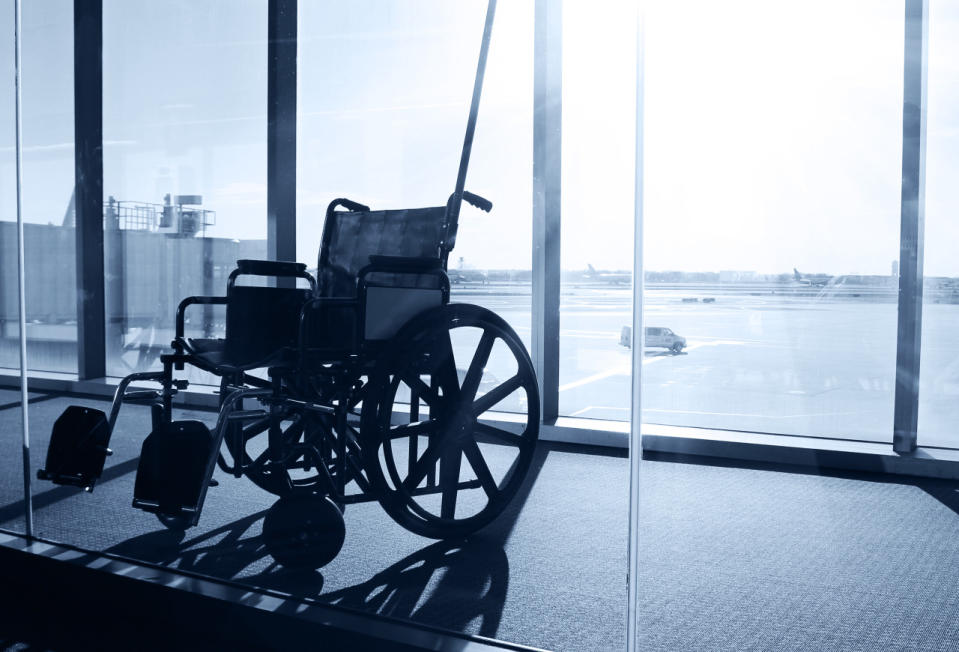
Photo: Thinkstock
If you feel that an airline has violated your civil rights, you should call the Department of Transportation to make a formal complaint, says Baldwin. A spokesperson for the DOT told Yahoo Travel that all disability-related complaints that the Department receives are investigated, and if there’s a clear pattern or practice of violations of the ACAA by a particular carrier, enforcement action is taken. (In 2013, for example, the department issued a $1.2 million civil penalty to one carrier, and in 2011, $2 million to another.)
But these investigations are cumbersome, and take time. “The airlines won’t change unless they’re specifically told by the federal government they have to,” adds Kuusisto. That’s why he recommends also emailing your United States representative and Senator, asking them to give money to the Federal Aviation Administration (FAA) to start testing wheelchair restrain systems that can be used safely in airplane cabins. (You can also sign this link.) One nonprofit, All Wheels Up, has obtained funding to test these systems: “The FAA is interested, but they need Congress to release money to them to make this happen,” says the group’s founder, Michelle Irwin, who has an 8-year-old son in a wheelchair due to spinal muscular atrophy.

Allen and the good guys (Photo: Jeanne Allen)
There are also heartwarming stories out there. For every unpleasant flight attendant he encounters, Kuusisto says he encounters several who are pleasant and cordial. “I have pilots who specifically come back to talk to me about their dogs, or flight attendants who insist that Nira is the nicest passenger they’ve had today,” he says. One time, while traveling, a connecting flight got cancelled, and “the whole crew insisted that Nira and I couldn’t sleep in the airport and they got us a hotel voucher. I was really touched.”
And Allen remembers fondly this past April, when two crew members from American Eagle hauled her up a flight of stairs to get into the plane. “I felt it was above and beyond the call of duty, but they did it cheerfully, smiling and cracking jokes, and without a complaint,” she says. “They could have made me feel like a burden, but they really made it clear to me that it was their pleasure. That’s the way, frankly, it always should be.”
Let Yahoo Travel inspire you every day. Hang out with us on Facebook, Twitter, Instagram, and Pinterest. Check out our original adventure travel series A Broad Abroad.

